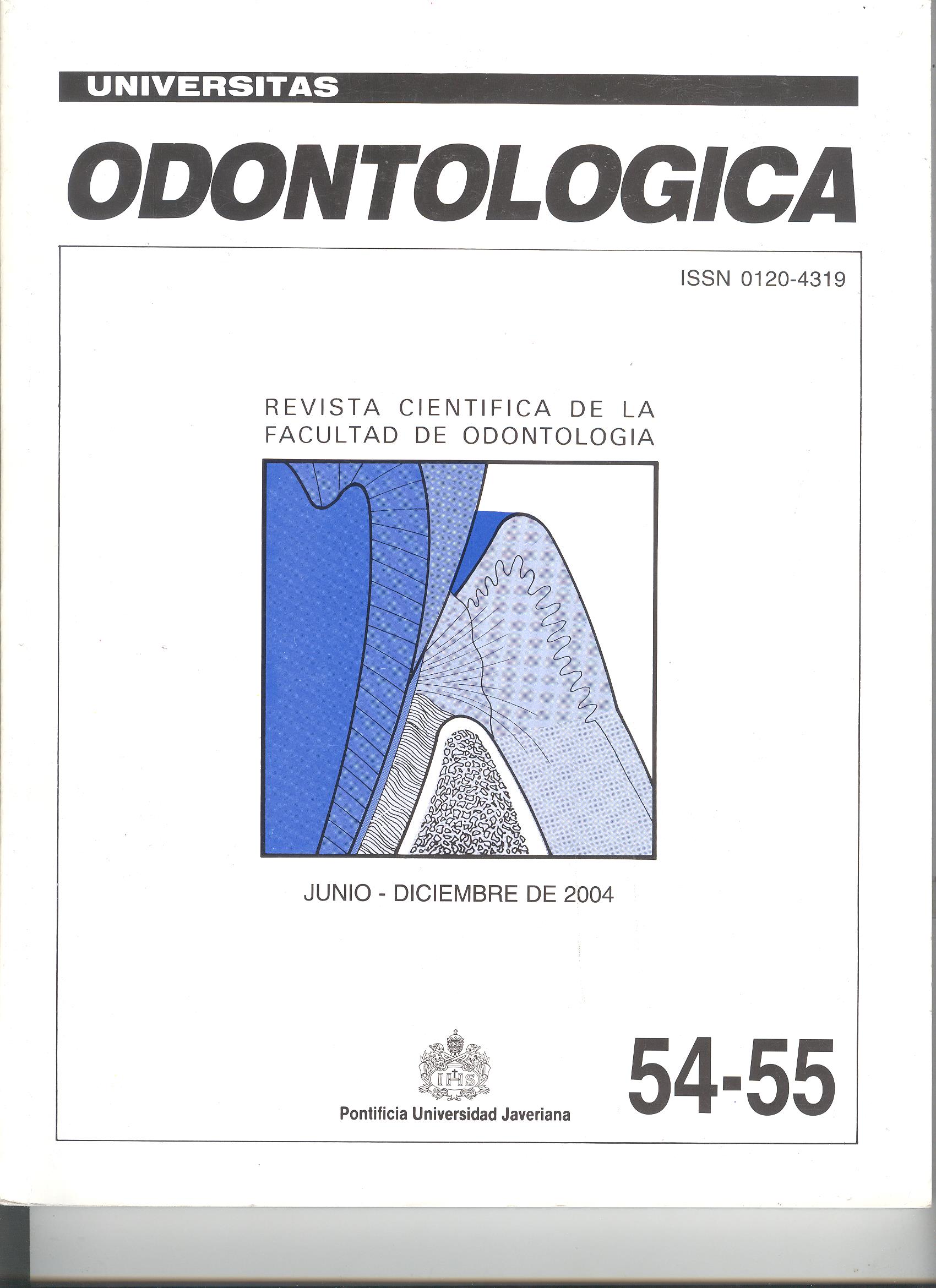Resumo
ANTECEDENTES: obtener un nivel decubrimiento radicular predecible y estéticoha sido uno de los propósitos dela cirugía mucogingival. Recientemente,el tratamiento de las recesionesgingivales se ha convertido en una necesidadestética ante la cual se han propuestodiferentes modalidades detratamiento quirúrgico. OBJETIVO: compararel nivel de cubrimiento radicular(CR) obtenido con la utilización del plasmarico en plaquetas autólogo (PRPa)previo al injerto de tejido conectivo (ITC), con la utilización del ITC únicamente.MÉTODOS: este experimento clínicocontrolado a boca dividida fue realizadoen 24 dientes de 8 pacientes con recesionesgingivales bilaterales clase I o IIde Miller, seleccionados al azar para elgrupo experimental (PRPa e ITC). El dientecontralateral fue asignado al grupocontrol (ITC). Un examinador ciego realizólas mediciones al inicio y tres mesesdespués, que incluyeron: margengingival, profundidad al sondaje, nivel deinserción clínico, cantidad de encía adheriday distancia mesodistal del defecto.Los datos fueron analizados con laprueba t de Student (p£0.05). RESULTADOS:ambos tratamientos mostraronresultados clínica y estadísticamentesignificativos para el CR. El porcentajepromedio de CR en el grupo control fuede 96 ± 42.7% y para el grupo experimentalfue de 119.3 ±43.3%. Aunque hubomejores resultados con la utilización delPRPa, las diferencias entre ambos gruposno fueron estadísticamente significativas (p=0.198). CONCLUSIONES:la aplicación de PRPa no mejorasignificativamente el resultado clínico,al utilizar colgajos posicionadoscoronales con ITC, en el tratamiento delas recesiones gingivales.
Nery EB, Davies EE. The Historical developmentof mucogingival surgery. J West Soc Perio 1976winter; 21(4): 149-61
Guinard EA, Caffesse RG. Treatment of localizedgingival recessions, part I. Lateral sliding flaps. JPeriodontol 1978 Jul; 49(7): 351-5
Caffesse RG, Guinard EA. Treatment of localizedgingival recessions part II. Coronally repositionedflap with a free gingival graft. J Periodontol 1978Jul; 49(7): 357-61
Hall W. Gingival augmentation/mucogingivalsurgery. Section VII. In: American Academy ofPeriodontology: Princeton, NJ, USA: Proceedingsof the world workshop in clinical periodontics,1989, July 23-27
Langer B, Langer L. Subepithelial connectivetissue graft technique for root coverage.J Periodontol 1985 Dec; 56(12): 715-20
Nelson SW. The subpedicle connective tissuegraft, a bilaminar reconstructive procedurefor the coverage of denuded root surface.J Periodontol 1987 Feb; 58(2): 95-102
Harris RJ. The connective tissue and partialthickness double pedicle graft: A predictablemethod of obtaining root coverage. J Periodontol1992 May; 63(5): 477-86
Tinti C, Vincenzi GP. The treatment of gingivalrecession with “guided tissue regeneration”procedures by means of Gore-Tex membranes.Quintessence Int 1990; 6: 465-8
Greenwell H, Bissada NF, Henderson RD, DodgeJR. The deceptive nature of root coverage results.J Periodontol 2000 Aug; 71(8): 1327-7
Pini Prato G, Clauser C, Cortellini P, Tinti C,Vincenzi G, Pagliaro U. Guided tissue regenerationversus mucogingival surgery in the treatment ofhuman buccal recessions. A 4-year follow-upstudy. J Periodontol 1996 Nov; 67(11): 1216-23
Rosetti EP, Marcantonio RA, Rossa C, ChavesES, Goissis G, Marcantonio E. Treatment ofgingival recession: Comparative study betweensubepithelial connective tissue graft and guidedtissue regeneration. J Periodontol 2000 Sep; 71(9):1441-47
Graves DT, Cochran DL. Periodontal regenerationwith polypeptide growth factors. Curr OpinPeriodontol 1994: 178-86
Matsuda N, Lin Wl, Kumar M, Cho I, Genco RJ.Mitogenic chemotactic and synthetic responsesof rat periodontal ligament cell to polypeptidegrowth factors in vitro. J Periodontol 1992 Jun;63(6): 515-25
Mumford J, Carnes D, Cochran D, Oates T. Theeffects of platelet-derived growth factor-BBon periodontal cells in an in vitro wound model.J Periodontol 2001 Mar; 72(3): 331-40
Oates T, Rouse CH, Cochran D. Mitogenic effectsof growth factors on human periodontal ligamentcells in vitro. J Periodontol 1993 Feb; 64(2):142-8
Whitman D, Berry H, Green DM. Platelet gel: Anautologous alternative to fibrin glue withapplications in oral and maxillofacial surgery. JOral Maxillofacial Surg 1997; 55: 1294-99
Marx R, Carlson E, Eichstaedt R, Schimmele S,Strauss J, Georgeff K. Platelet-rich plasma:Growth factor enhancement for bone grafts. OralSurg Oral Med Oral Pathol Oral Radiol Endod1998 Jun; 85(6): 638-46
Assoian RK, Grotendorst G, Muller D, Sporn M.Cellular transformation by coordinated action ofthe peptide growth factors from human platelets.Nature 1984; 309: 804-06
de Obarrio JJ, Arauz-Dutari JI, Chamberlain TM,Croston A. The use of autologous growth factorsin periodontal surgical therapy: Platelet gelbiotechnology. Case reports. Int J PeriodonticsRestorative Dent 2000; 20(5): 487-97
Miller PD. A classification of marginal tissuerecession. Int J Periodontics Restorative Dent1985; 5(2): 9-13

Este trabalho está licenciado sob uma licença Creative Commons Attribution 4.0 International License.
Copyright (c) 2004 Universitas Odontologica


